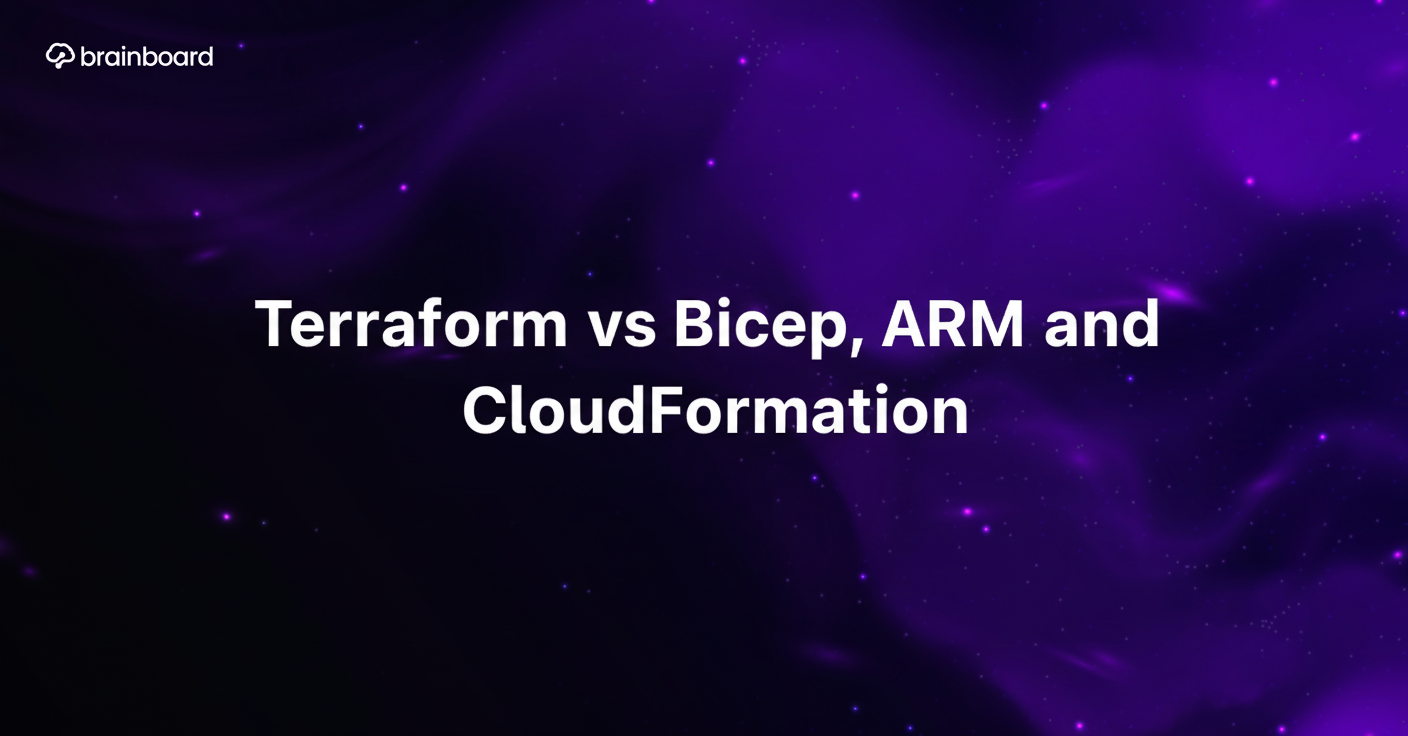Where to start?
A lot of noise out there about IaC tooling, and every tool is opinionated, has its defenders, lovers, and haters.
So, have you ever felt like you’re standing at a crossroads, trying to pick the “perfect” Infrastructure as Code (IaC) tool for your project, team or organizations? That’s pretty common to all of us (I mean, cloud engineers, DevOps, SREs, platform engineer…name it). It’s even periodic, this debate comes regularly in conversation about IaC tooling.
Let’s dive into this puzzle and try to clear the picture. Hopefully by the end of this article, you’ll have a crystal-clear understanding of which tool fits your needs like a glove. Whether you’re a startup founder trying to keep costs down or an enterprise architect managing multi-cloud complexity.
Understanding the IaC landscape
In a nutshell, Infrastructure as Code is your cloud’s recipe book. Instead of clicking through endless console screens (and forgetting what you clicked last week), you write your infrastructure requirements in code. It’s like the difference between giving someone verbal directions to your house versus sending them a GPS coordinate – one’s prone to errors, the other’s precise and repeatable.
The tools we’re comparing today are the master chefs of this kitchen. Each one has developed its own cooking style, and understanding these differences will help you pick the right one.
What is Terraform and why developers love it
Terraform is like the Swiss Army knife of IaC tools. Created by HashiCorp, it doesn’t play favorites with cloud providers – it works with AWS, Azure, Google Cloud, and even your on-premises infrastructure. Imagine having a universal remote that controls every TV in your house, regardless of the brand. That’s Terraform for you.
What makes Terraform special is its declarative approach using HCL (HashiCorp Configuration Language). You tell it what you want your infrastructure to look like, and it figures out how to get there. It’s like ordering a custom cake – you describe the end result, and the baker handles the messy details.
The real magic happens with Terraform’s state management. It keeps track of what it’s created, making updates and deletions a breeze. Have you ever tried to remember which resources you manually created six months ago? Yeah, Terraform solves that headache.
ARM templates: Microsoft’s original recipe
ARM (Azure Resource Manager) templates were Microsoft’s first serious attempt at IaC for Azure. Written in JSON, they’re incredibly powerful but about as fun to write as tax forms. If you’ve ever stared at nested JSON objects until your eyes crossed, you know what I mean.
Despite their complexity, ARM templates offer unparalleled control over Azure resources. They’re like having the original blueprints to a building – detailed, comprehensive, but requiring an engineering degree to fully understand. Every Azure service supports ARM templates from day one, which means you’ll never hit a compatibility wall.
The learning curve? It’s steep enough to make experienced developers reach for their third cup of coffee. But once you master ARM templates, you can orchestrate Azure resources with surgical precision.
Bicep: ARM’s cooler younger sibling
Enter Bicep – Microsoft’s answer to “What if ARM templates didn’t make developers cry?” Launched as a domain-specific language (DSL) for Azure, Bicep takes everything powerful about ARM templates and wraps it in a syntax that won’t give you nightmares.
Writing Bicep feels like having a conversation with Azure rather than filling out legal documents. It compiles down to ARM templates, so you get all the power without the pain. Think of it as ARM templates with a user-friendly interface – like switching from command line to a graphical interface, but for infrastructure code.
The best part? Bicep integrates seamlessly with Azure’s ecosystem. If you’re all-in on Azure, Bicep feels like it was tailor-made for your needs (because it was). The learning resources are fantastic, and the VS Code extension provides IntelliSense that makes writing infrastructure code almost enjoyable.
CloudFormation: AWS’s native solution
CloudFormation is AWS’s homegrown IaC solution, and it shows. Like that friend who knows every shortcut in their hometown, CloudFormation knows AWS inside and out. It supports both JSON and YAML formats, giving you flexibility in how you write your templates.
What sets CloudFormation apart is its deep integration with AWS services. New AWS features often land in CloudFormation before third-party tools catch up. It’s like having a backstage pass at a concert – you get access to everything first.
The stack-based approach CloudFormation uses makes managing related resources intuitive. You can create, update, and delete entire application stacks as single units. However, if you’re planning to venture outside AWS, CloudFormation won’t follow you there – it’s AWS or bust.
Head-to-head comparison: key differences that matter
Let’s cut to the chase and compare these tools where it really counts.
Multi-cloud support
Terraform wins this round hands down. It’s the polyglot of IaC tools, speaking fluently with over 300 providers. Bicep and ARM templates are Azure-exclusive, while CloudFormation is married to AWS. If you’re planning a multi-cloud strategy or might switch providers, Terraform’s your safest bet.
Learning curve and developer experience
Bicep takes the crown for ease of use if you’re in Azure land. Its syntax is clean, intuitive, and the tooling is exceptional. Terraform comes in second with its relatively straightforward HCL syntax. CloudFormation and ARM templates? They’re tied for last place in the user-friendliness race.
Community and ecosystem
Terraform’s community is massive and active. You’ll find modules for almost anything you can imagine, from simple web servers to complex Kubernetes deployments. CloudFormation has strong community support within the AWS ecosystem. Bicep’s community is growing rapidly, while ARM templates have a mature but less enthusiastic following.
State management
This is where things get interesting. Terraform manages state explicitly, which can be both a blessing and a curse. You need to handle state files carefully, especially in team environments. CloudFormation and Azure’s tools manage state implicitly through their respective clouds, removing this burden but also some flexibility.
Real-world use cases: when to use what
Let me paint you some scenarios to help you visualize when each tool shines.
Scenario 1: The Azure-first startup
You’re building a SaaS product entirely on Azure. Your team is small but growing, and you need to move fast. Bicep is your best friend here. It’ll get you up and running quickly, the documentation is stellar, and you won’t waste time on multi-cloud features you don’t need.
Also, if at anytime you feel the need to migrate to Terraform/OpenTofu, Microsoft Azure has an IaC exporter that can export your templates into Terraform. You can also use Brainboard to import all your infrastructure, and generate Terraform code for it (with diagram and tfstate).
Scenario 2: The multi-cloud enterprise
Your company uses AWS for compute, Azure for analytics, and Google Cloud for machine learning. Only Terraform can juggle all these balls without dropping one. Yes, you’ll need to manage state files and deal with provider versioning, but the alternative is maintaining three different IaC tools.
Scenario 3: The AWS powerhouse
You’re deep in the AWS ecosystem, using everything from Lambda to SageMaker. CloudFormation ensures you’re always using the latest AWS features and provides the tightest integration possible. The native drift detection and rollback capabilities give you peace of mind.
Scenario 4: The legacy migration
You’ve got existing ARM templates from years of Azure deployments. Stick with ARM templates or gradually migrate to Bicep or Terraform.
Performance and scalability considerations
When it comes to deployment speed, native tools (CloudFormation for AWS, Bicep/ARM for Azure) typically edge out Terraform. They don’t need to translate between different APIs, making them slightly faster for large-scale deployments.
However, Terraform’s parallel execution capabilities is a game changer. It can spin up independent resources simultaneously, often making up for any API translation overhead. I’ve seen Terraform deployments with hundreds of resources complete in minutes.
For truly massive infrastructures, all these tools can handle the load, but the approach differs. CloudFormation’s nested stacks and Terraform’s module system both enable you to break down complex infrastructures into manageable chunks. Bicep’s module system is newer but equally capable.
Cost implications and licensing
Here’s something that might surprise you: all these tools are free to use! But the devil’s in the details.
Terraform is no longer an open-source, but OpenTofu is as HashiCorp changed the license into BSL. CloudFormation charges only for the AWS resources you create, not for the service itself. Similarly, Bicep and ARM templates are free, with costs only for the Azure resources.
The real cost consideration is operational. How much time will your team spend learning and maintaining the tool? Terraform’s multi-cloud capability might save you from hiring cloud-specific experts. Conversely, using native tools might reduce debugging time and complexity.
Integration with CI/CD pipelines
Modern DevOps is all about automation, and these tools need to play nice with your CI/CD pipelines.
Terraform integrates beautifully with most CI/CD platforms. Its plan and apply workflow fits naturally into pipeline stages. You can review planned changes before applying them, adding a safety net to your deployments.
CloudFormation integrates seamlessly with AWS CodePipeline and other AWS developer tools. If you’re using GitHub Actions or Jenkins, CloudFormation works well there too, though you might need to write some wrapper scripts.
Bicep shines in Azure DevOps pipelines, obviously, but it also works great with GitHub Actions. The Azure CLI includes Bicep support, making integration straightforward regardless of your CI/CD platform.
Making the decision: your action plan
So, how do you choose? Start by answering these questions:
- How important is the learning curve for your team?
- Do you need to manage existing infrastructure?
- What’s your team’s experience level with IaC?
- How complex is your infrastructure?
If you’re single-cloud and want the path of least resistance, go native (CloudFormation for AWS, Bicep for Azure). If you’re multi-cloud or value provider independence, Terraform is your answer. If you have existing ARM templates, consider Bicep for new projects while maintaining ARM for legacy systems.
Conclusion
Choosing between Terraform, Bicep, ARM templates, and CloudFormation isn’t about finding the “best” tool – it’s about finding the right tool for your specific needs. Each has its sweet spot, and understanding these nuances helps you make an informed decision.
The cloud infrastructure landscape will continue evolving, but mastering any of these tools puts you ahead of the curve. Pick one, dive deep, and start automating. The best IaC tool is the one you actually use.
FAQs
Can I use multiple IaC tools in the same project?
Absolutely! Many organizations use Terraform for multi-cloud resources and native tools for cloud-specific features. Just be careful about resource overlap and maintain clear boundaries between what each tool manages.
How do I migrate from one IaC tool to another?
Start by importing existing resources into the new tool (most support import functionality). Then gradually rewrite templates, testing thoroughly in non-production environments. Consider running both tools in parallel during the transition period.
Which tool has the best support for Kubernetes?
Terraform has excellent Kubernetes support through its Kubernetes provider, while cloud-native tools handle Kubernetes through their respective managed services (EKS for CloudFormation, AKS for Bicep/ARM). For pure Kubernetes work, also consider Helm or Kustomize.
Is it worth learning multiple IaC tools?
I don’t believe it is worth learning multiple IaC languages. Better to be expert in one (Terraform is a must) and have basic understanding of the other tools/languages.
What about newer tools like Pulumi or CDK?
Pulumi and AWS CDK are great alternatives in the IaC landscape, using general-purpose programming languages. They’re worth exploring if you prefer writing infrastructure in languages like Python or TypeScript, but they have smaller communities and ecosystems compared to the other tools.

